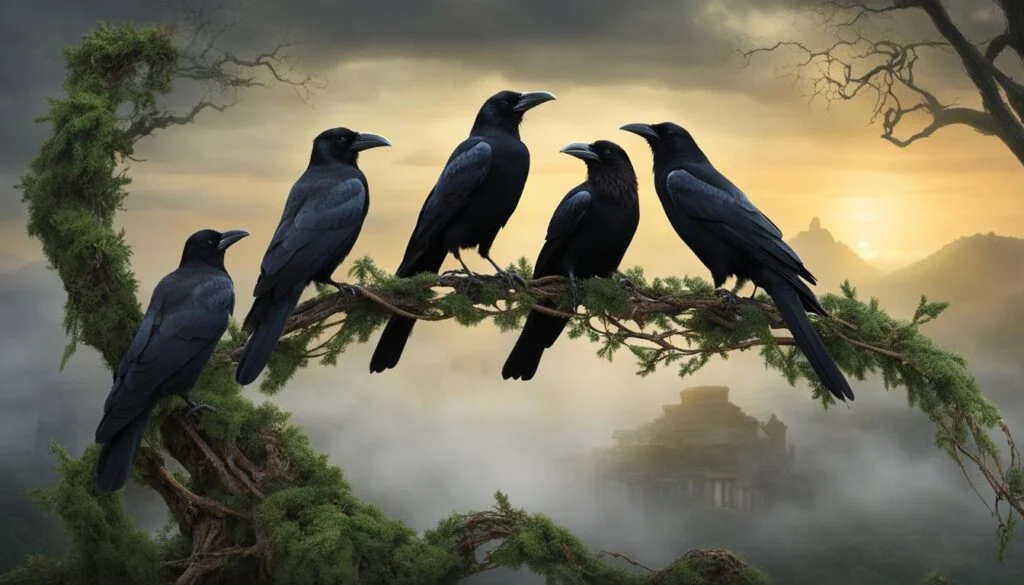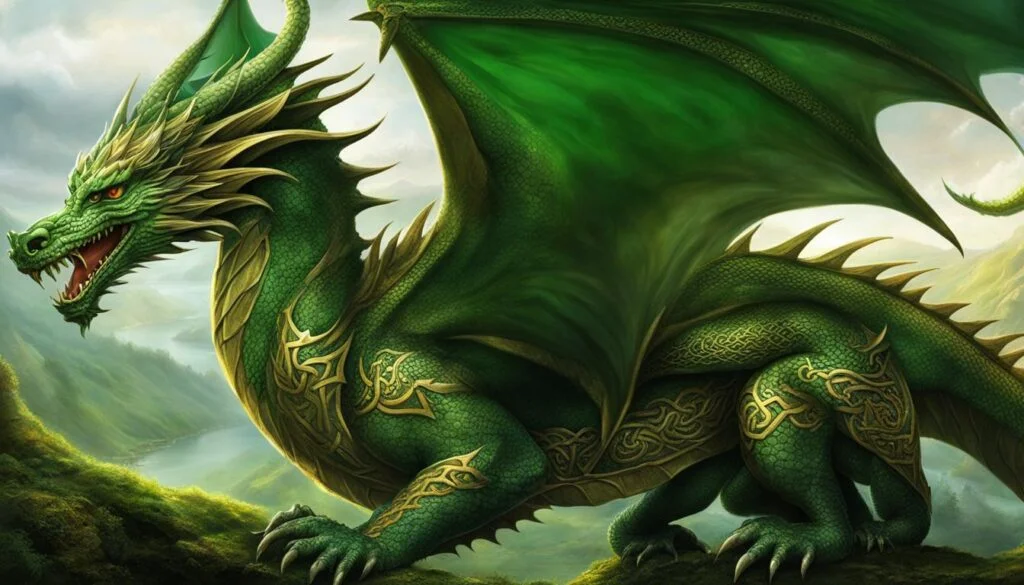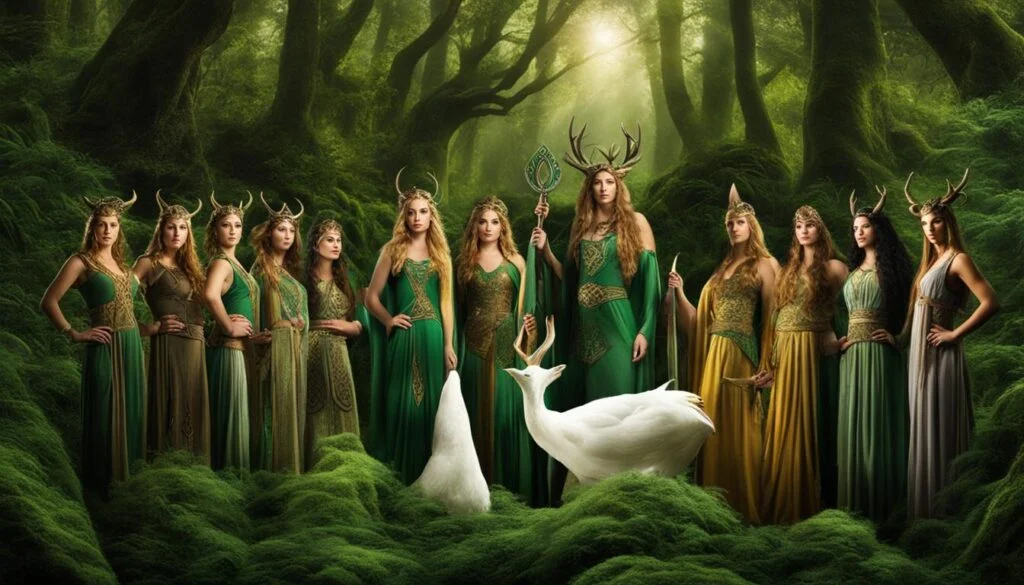In Celtic mythology, crows hold significant symbolism and play a prominent role in the folklore and legends of the ancient Celts.
According to Celtic mythology, crows were believed to be divine messengers or aspects of the Morrigan, a war goddess.
They were seen as allies of the downtrodden and were associated with the supernatural.
Over time, however, crows became linked to death and dying, losing their status as divine messengers and embracing their role as symbols of the afterlife.
Throughout Celtic legend and folklore, crows are often associated with war, battle, and the Otherworld.
The Morrigan, a trio of war goddesses, is frequently depicted in the form of a crow, representing death and destruction.
Crows are also considered messengers between the human and divine realms, carrying important information.
In Celtic tales and legends, crows have a presence that highlights their significance as symbols of power, protection, and guidance.
They are associated with notable figures such as Taliesin, Owain, and Cuchulain, playing pivotal roles in their stories.
Ravens, a close cousin of crows, also hold symbolic importance in Celtic mythology and share connections with Norse mythology.
The Morrigan, a central figure in Celtic mythology, is strongly associated with crows and ravens.
Seen as a trio of goddesses, the Morrigan often takes the form of black birds, particularly crows.
In battle, she is known as the “Crow of Battle” and serves as a protective symbol for warriors.
Today, crows and ravens continue to captivate our imaginations and hold cultural significance.
They are often seen as symbols of wisdom, transformation, and magic. Their connection to death, war, and the supernatural remains prevalent in modern interpretations, literature, and art.
The continued fascination with crow symbolism in Celtic mythology reflects our intrigue with the mysteries of life and the ancient traditions that have shaped our culture.
Crows and ravens serve as reminders of the rich folklore that connects us to our past and the wisdom it holds.
Key Takeaways:
- Crows in Celtic mythology hold significant symbolism and are associated with war, battle, and the Otherworld.
- They were believed to be divine messengers or aspects of the war goddess Morrigan.
- Crows are seen as messengers between the human and divine realms, carrying important information.
- They symbolize power, protection, and guidance in Celtic tales and legends.
- The Morrigan, a prominent figure in Celtic mythology, is strongly associated with crows and ravens.
The Role of Crows in Celtic Legend and Folklore
In Celtic mythos, crows hold a prominent place in both legend and folklore. These mysterious birds have deep symbolic significance in Celtic culture, representing various themes and concepts.
Let’s delve into the beliefs and symbolism surrounding crows in Celtic mythology.
The Significance of Crows in Celtic Culture
In Celtic beliefs, crows are often associated with war and battle, representing death and destruction.
They are regarded as messengers of the gods, carrying vital information between the human and divine realms.
Crows are considered wise creatures, possessing knowledge and secrets of the supernatural world.
Their connection to war and wisdom makes them powerful symbols in Celtic culture.
The Morrigan: Goddess of War and the Crow
One of the most notable figures associated with crows in Celtic mythology is the Morrigan.
She is a war goddess often depicted in the form of a crow. The Morrigan, also known as “the Crow of Battle” or the “Battle Crow,” embodies the fierce and protective aspects of crows.
Her presence signals imminent warfare and serves as a symbol of strength and guidance for warriors.
Crows as Symbols of Transformation
Additionally, crows hold symbolic significance in Celtic mythology as agents of transformation.
They represent the ability to navigate between worlds and undergo metamorphosis.
In folklore, crows are sometimes believed to be transformed human beings or divine beings taking the form of crows.
This connection with transformation reflects the belief in the inherent magic and mystical nature of these intelligent birds.
The role of crows in Celtic legend and folklore is multifaceted and deeply ingrained in the culture’s beliefs and symbolism.
As messengers, protectors, and symbols of wisdom, crows continue to captivate our imaginations and connect us to the ancient traditions and wisdom of Celtic mythology.
Crows in Celtic Mythology: Tales and Legends
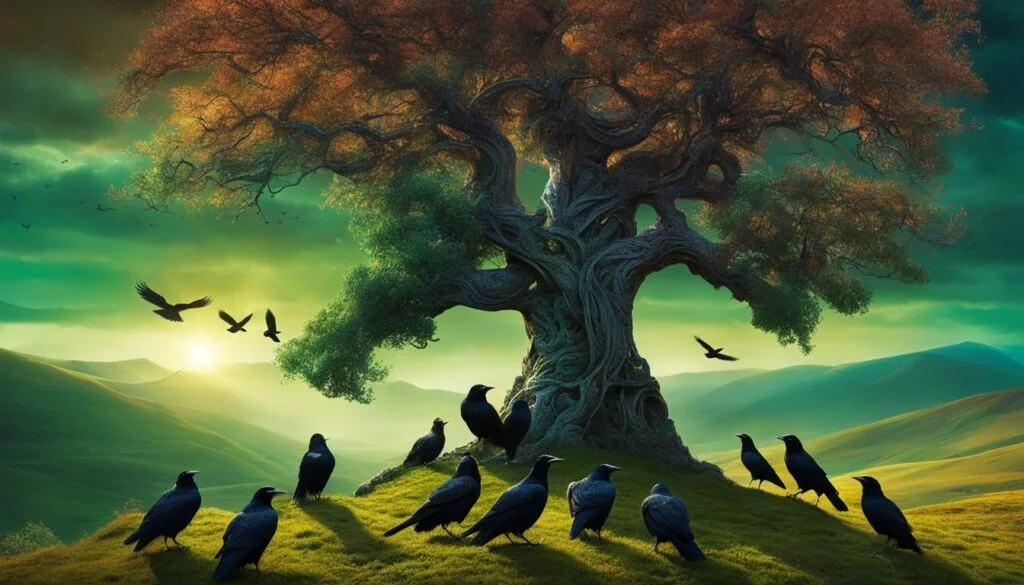
In Celtic mythology, crows hold deep symbolic significance and are present in various tales and legends.
These stories shed light on the cultural associations and beliefs surrounding these mystical birds.
Let’s explore some fascinating tales that highlight the importance of crows in Celtic tradition:
1. The Mabinogion
In the Mabinogion, a collection of Welsh tales, crows make appearances that weave intricate narratives.
For example, Taliesin, a renowned poet and bard, claims to have escaped danger by transforming into a crow.
In another tale, the hero Owain commands an army of ravens, who aid him in securing victory on the battlefield.
These stories depict crows as guides and protectors, emphasizing their connection to power and magic.
2. Cuchulain and the Morrigan
In Irish mythology, the figure of Cuchulain is closely associated with the Morrigan, who often appears in the form of a raven.
Throughout his life, Cuchulain is followed by the Morrigan in her raven aspect, serving as a constant reminder of impending battle and the supernatural.
This association between crows and warriors underscores their role as symbols of protection, guidance, and the Otherworld.
3. Crow Symbolism in Celtic Legends
Various Celtic legends feature crows as powerful symbols. One such legend revolves around Bran the Blessed, a giant warrior whose name translates to “raven.”
Bran’s severed head continues to speak and offers protection to Britain, highlighting the bird’s connection to guardianship and the supernatural.
Other notable figures, including Cerridwen’s son Afagddu, are also linked to ravens, further cementing their symbolism of wisdom, transformation, and the divine.
These captivating tales and legends illustrate the enduring significance of crows in Celtic mythology.
Through their associations with power, protection, guidance, and the Otherworld, crows have become integral to the rich cultural tapestry of Celtic tradition.
The Morrigan and the Raven Connection
In Celtic mythology, the figure known as the Morrigan holds a special connection to crows and ravens.
Often depicted as a trio of goddesses – Macha, Badb, and Nemain – the Morrigan is known to take on the form of black birds, particularly crows.
These bird forms of the Morrigan serve as symbols of death, war, and the supernatural.
As “the Crow of Battle” or the “Battle Crow,” the Morrigan signifies the imminence of warfare and offers protection to warriors.
With her presence, she brings a sense of foreboding and serves as a potent symbol of both fear and reverence.
The Morrigan’s association with crows emphasizes their connection to death, the Otherworld, and the supernatural realms.
The Morrigan’s connection to ravens is also significant. Ravens, like crows, are often associated with war and battle in Celtic mythology.
Their presence is seen as a sign of impending conflict and serves as a protector for warriors.
This connection between the Morrigan and both crows and ravens underscores their shared symbolism of power, protection, and the mysteries of life and death.
Ravens in Celtic Mythology and Norse Influence
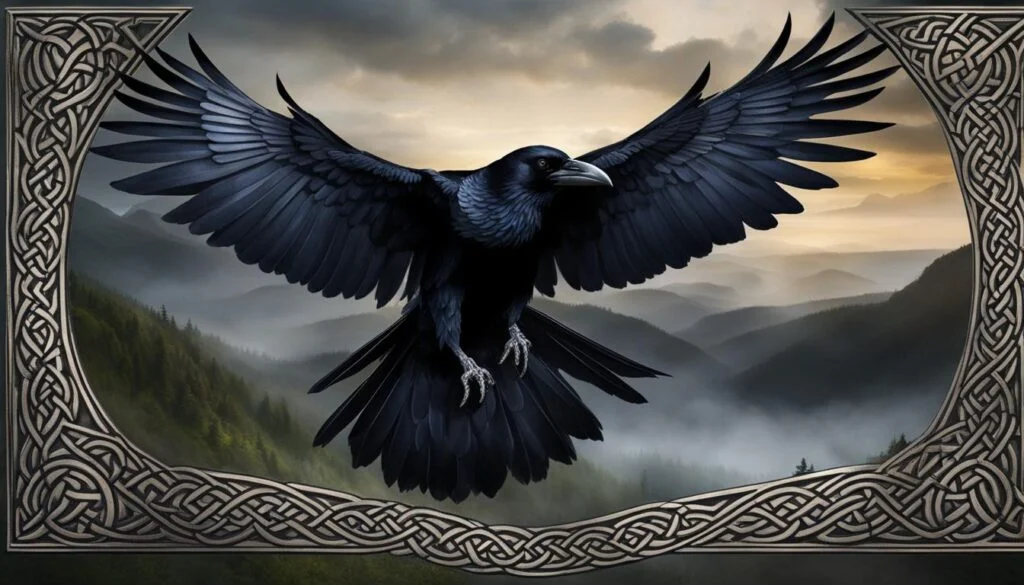
In Celtic mythology, ravens hold significant symbolism, much like their crow counterparts.
However, their significance is not limited to Celtic folklore alone. The Norse influence on Celtic mythology also contributed to the importance of ravens in the ancient tales.
The Norse god Odin, known for his wisdom and connection to magic, had two ravens named Huginn and Muninn.
These ravens served as his messengers and scouts, flying across the nine realms to gather information and relay it back to Odin.
They symbolized his omniscience and the knowledge he possessed.
Ravens are also associated with the Valkyries, the female warriors who served Odin and chose the slain warriors on the battlefield.
These fierce warriors rode into battle on horseback, accompanied by ravens flying overhead.
The ravens would feast on the fallen warriors, carrying their souls to the afterlife and serving as a symbol of honor and bravery in death.
The Connection Between Celtic and Norse Symbolism
The presence of ravens in both Celtic and Norse mythologies highlights the connection between these ancient cultures.
The Celtic and Norse peoples had interactions and shared cultural elements, leading to the blending of their mythologies.
This is particularly evident in the symbolism and significance attributed to ravens.
Both Celtic and Norse traditions recognized the wisdom, intelligence, and otherworldly nature of these birds.
They saw ravens as messengers between the human and divine realms, as well as symbols of protection and guidance.
The association of ravens with war, death, and the supernatural further solidifies their importance in the mythology of both cultures.
The Enduring Symbolism of Ravens
The symbolism of ravens in Celtic mythology continues to captivate our imaginations today.
These majestic birds represent wisdom, transformation, and the mysteries of the supernatural.
Their presence in Celtic and Norse mythologies serves as a reminder of the ancient traditions and beliefs that shaped the cultures of the past.
Whether depicted in art, literature, or passed down through oral traditions, the symbolism of ravens resonates with our fascination for the mystical and magical.
Ravens connect us to a world beyond our own, where ancient gods and warriors roam.
They remind us of the enduring legacy of Celtic mythology and the cultural connections that span across time and space.
Legends of Bran the Blessed and Other Raven-Associated Figures
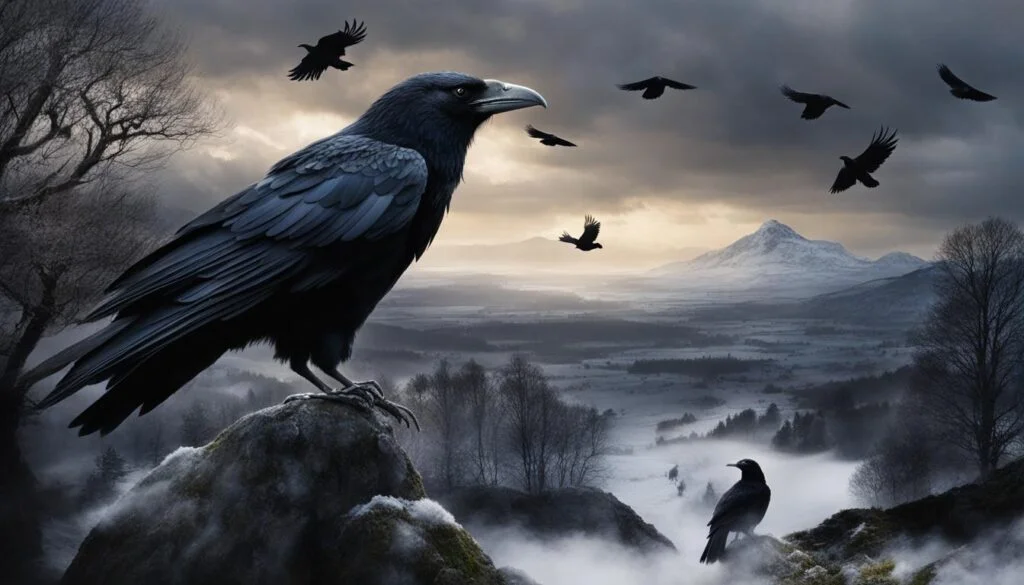
Celtic mythology is replete with tales and legends that celebrate the significance of ravens.
One of the most prominent figures associated with ravens is Bran the Blessed.
In Celtic mythology, Bran is revered as a giant warrior with immense strength, and his very name means “raven.”
His connection to ravens is further accentuated by the fact that his head continued to speak even after being severed from his body.
The burial of his head at the White Mount in London serves as a symbol of his protective presence for Britain.
Bran’s association with ravens exemplifies the reverence and symbolism attributed to these majestic birds in Celtic lore.
In addition to Bran, other figures in Celtic mythology have connections to ravens as well.
Cuchulain, the Irish mythological hero, is followed throughout his life by the Morrigan in her raven form.
The Morrigan, often depicted as a trio of war goddesses, embodying the aspects of Macha, Badb, and Nemain, further adds to the mystique surrounding ravens in Celtic mythology.
Similarly, Afagddu, the son of the Irish goddess Cerridwen, is also linked to ravens.
These legends and associations highlight the deep-rooted reverence for ravens and their symbolic association with protection, wisdom, and the supernatural in Celtic culture.
The Symbolism of Ravens in Celtic Legends:
- Ravens as protectors of Britain: The burial of Bran’s head at the White Mount in London symbolizes his everlasting protection over Britain, echoing the belief in the guardianship offered by ravens.
. - Ravens as messengers and guides: The association of ravens with heroes like Cuchulain and the Morrigan signifies their role as messengers and guides between the mortal and divine realms.
. - Ravens as symbols of wisdom and supernatural insight: The ability of Bran’s severed head to speak and impart wisdom showcases the association of ravens with supernatural knowledge and understanding.
. - Ravens as embodiments of power and strength: Bran’s immense strength and his status as a giant warrior underscore the symbolic connection between ravens and power.
The legends of Bran the Blessed and other raven-associated figures in Celtic mythology vividly illustrate the enduring fascination and reverence for ravens.
These majestic birds continue to captivate our imaginations, reminding us of the rich cultural heritage embodied in Celtic mythology.
Their symbolism as protectors, messengers, and bearers of wisdom resonates across centuries, shaping our understanding of the supernatural and our connection to ancient traditions.
Ravens and Crows in Modern Interpretations and Beliefs
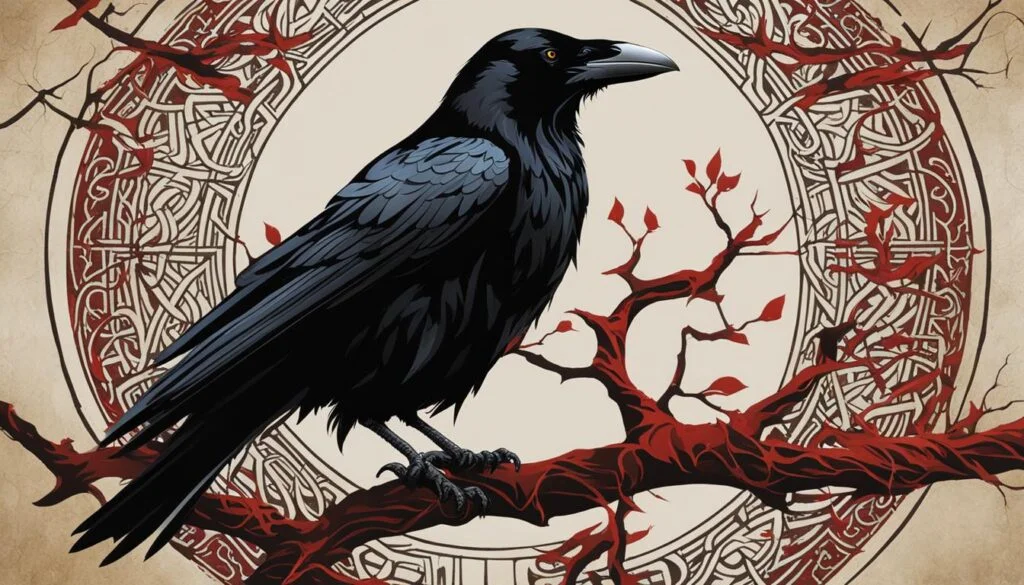
In modern times, the symbolism of crows and ravens in Celtic mythology continues to captivate our imaginations.
These mystical birds have taken on new meanings and interpretations, reflecting our evolving beliefs and cultural perspectives.
While their association with death and the Otherworld persists, contemporary interpretations also emphasize their connection to wisdom, transformation, and magic.
Contemporary beliefs about crows and ravens often highlight their intelligence and adaptability.
They are seen as resilient creatures that can thrive even in challenging environments.
Many cultures view them as messengers between realms, carrying important information from the supernatural to the human world.
Their presence is often considered a sign of guidance and protection, symbolizing the spirits of loved ones or divine beings watching over us.
Modern interpretations of Celtic crow symbolism
- In literature and art, crows and ravens are often portrayed as symbols of mystery and intrigue. They represent the untamed forces of nature and the unknown, inviting us to explore the depths of our imagination and embrace the magic of the world around us.
. - In popular culture, these iconic birds have made their way into movies, books, and music as symbols of darkness, wisdom, and transformation. They serve as metaphors for personal growth, resilience, and the journey towards self-discovery.
. - Some individuals see crows and ravens as omens or guides, offering insights and messages from the universe. They are believed to possess ancient knowledge and can provide guidance and support during times of uncertainty.
. - The contemporary fascination with Celtic crow symbolism reflects our ongoing interest in ancient folklore, mythology, and the interconnectedness of nature and spirituality.
Ravens and Crows at the Tower of London
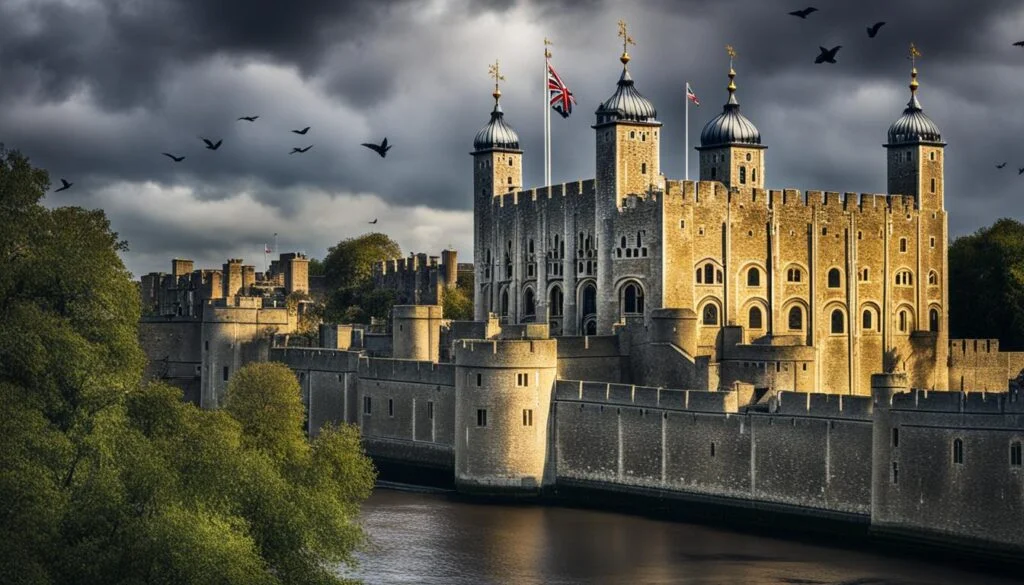
One of the most enduring and fascinating traditions in British history is the presence of ravens at the Tower of London.
For centuries, these majestic birds have been an integral part of the Tower’s mythology and folklore.
According to legend, if the ravens were to ever leave the Tower, it would spell disaster for the kingdom.
The Origins of the Tradition
The origins of the ravens at the Tower can be traced back to ancient Celtic and Norse mythology.
Ravens were believed to be messengers of the gods and held great significance in these mythological traditions.
Over time, the belief in the protective powers of the ravens became intertwined with the history and legends of the Tower of London.
The Ravens’ Role and Caretakers
Today, the ravens at the Tower are cared for by the Yeoman Warders, also known as Beefeaters.
These iconic guardians ensure that the ravens are well-fed, protected, and never leave the grounds of the Tower.
The ravens themselves are named and each has its own personality, adding to the allure and intrigue surrounding them.
A Symbol of Tradition and History
The presence of the ravens at the Tower of London is not only a testament to centuries-old traditions but also a symbol of the rich history and cultural heritage of Britain.
It serves as a reminder of the mystical and protective qualities attributed to these birds in Celtic and Norse mythology, and continues to captivate the imagination of visitors from around the world.
Myths and Symbols: Ravens and Crows in Art and Literature
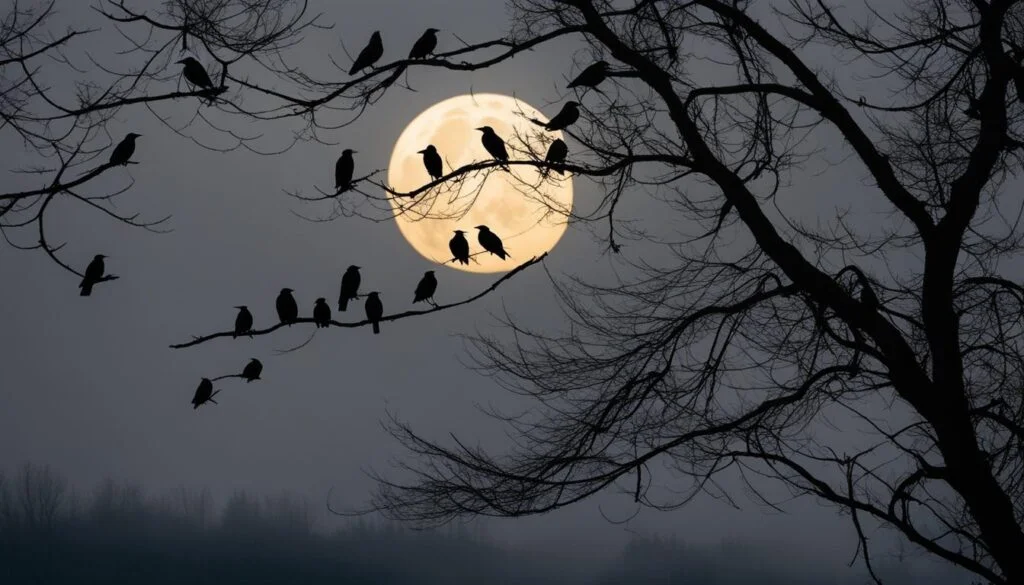
The symbolism of ravens and crows in Celtic mythology has not only influenced ancient beliefs but has also inspired various forms of artistic expression throughout history.
These mystical birds have captivated the imaginations of artists and writers, becoming powerful symbols of mystery, wisdom, and the supernatural.
In art, ravens and crows are often depicted in intricate designs, appearing on shields, weapons, and banners.
These images serve as reminders of their association with war, protection, and the Otherworld.
The intricate details in these artistic representations highlight the reverence and awe with which they were perceived in Celtic mythology.
In literature, crows and ravens have taken on different roles and meanings.
They are frequently portrayed as messengers, carrying important information between the mortal and divine realms.
These birds are also seen as guides, leading heroes through treacherous journeys and providing them with insights and wisdom.
The Influence of Celtic Symbolism in Literature
Celtic symbolism, including the representation of ravens and crows, has had a significant impact on various literary works.
These mythical birds often embody the themes of transformation, magic, and the mysteries of life.
They serve as powerful symbols that enrich the narrative and deepen the readers’ understanding of the story’s underlying themes.
- One notable example is Edgar Allan Poe’s famous poem The Raven, in which the raven itself becomes a haunting symbol of grief and loss. The raven’s repetitive refrain, “nevermore,” echoes the sense of despair and the eternal presence of death.
. - In J.R.R. Tolkien’s The Hobbit and The Lord of the Rings, the character of Gandalf possesses a deep connection with ravens. Known as the “Raven Wizard,” Gandalf’s association with these birds signifies his wisdom and his role as a guide and protector throughout the epic adventures.
. - Another example is the novel Crow Road by Iain Banks, where the crow symbolizes both the protagonist’s journey of self-discovery and the presence of the supernatural in his life.
The presence of crows and ravens in literature, whether as mystical guides, symbols of death, or guardians of ancient wisdom, continues to fascinate readers and adds depth to the narratives.
Their enduring symbolism and cultural importance make them captivating subjects for writers and readers alike.
The Timeless Appeal of Celtic Symbolism
The enduring fascination with ravens and crows in art and literature can be attributed to the timeless appeal of Celtic symbolism.
These birds have come to represent more than just creatures of myth; they embody the deep-rooted connection between humanity and the supernatural, and the weaving of ancient traditions into contemporary culture.
- Their symbolism as messengers and guides resonates with our yearning for wisdom, guidance, and connection to something greater than ourselves. They remind us of the mysteries of life and the presence of unseen forces that shape our existence.
. - Their association with death and the Otherworld challenges our understanding of mortality, reminding us of the transient nature of life and the interconnectedness of all things.
. - Their significance as protectors and guardians represents our innate desire for safety and protection, as well as our belief in the power of divine intervention.
Through art and literature, we continue to explore and celebrate the profound symbolism of crows and ravens in Celtic mythology.
These mystical birds serve as a bridge between the ancient and the modern, reminding us of the rich cultural heritage that has shaped our collective consciousness.
The Continued Fascination with Crow Symbolism in Celtic Mythology
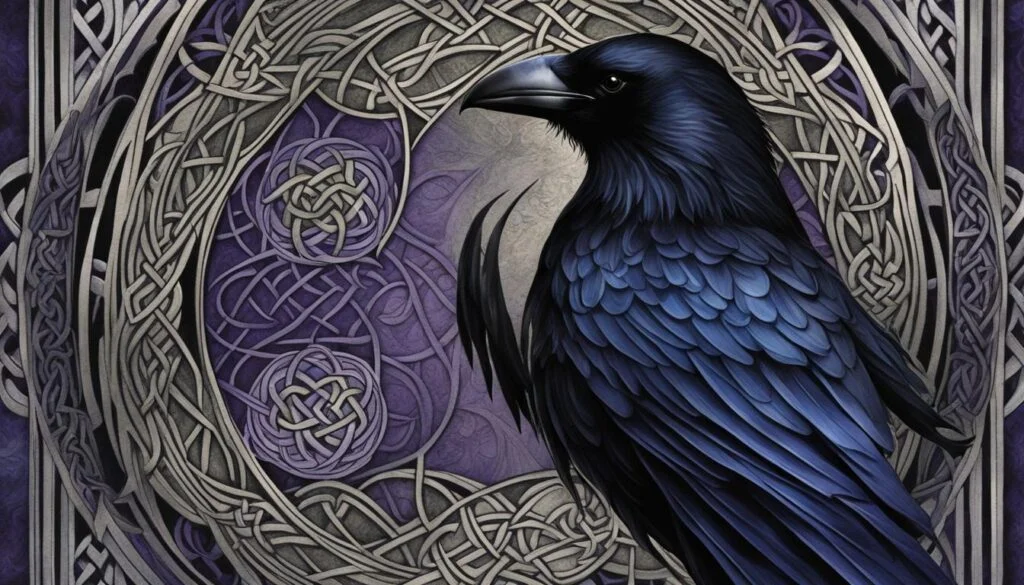
The enduring legacy of Celtic crow symbolism continues to captivate our imaginations and inspire fascination.
These mystical birds hold significant meaning in Celtic mythology, representing a connection to the supernatural, wisdom, and ancient traditions.
The cultural fascination with crows in Celtic mythology stems from their association with death, war, and the Otherworld, evoking a sense of mystery and intrigue.
In Celtic folklore, crows and ravens are revered as messengers and guides, carrying important information between realms.
Their wisdom and protective qualities make them symbols of power and guardianship.
The enduring legacy of crow symbolism is reflected in various cultural expressions, such as literature, art, and contemporary beliefs, keeping the significance of these birds alive in the hearts and minds of people.
Key Points:
- Crow symbolism in Celtic mythology captivates our imaginations and inspires fascination.
- Crows represent a connection to the supernatural, wisdom, and ancient traditions.
- The cultural fascination with crows comes from their association with death, war, and the Otherworld.
- Crows are revered as messengers and guides, embodying wisdom and protective qualities.
- The enduring legacy of crow symbolism is reflected in literature, art, and contemporary beliefs.
As we explore the rich folklore and mythology of the Celts, crows remain a symbol of cultural heritage and a reminder of the mysteries of life.
The fascination with crow symbolism endures, keeping these magnificent creatures at the center of Celtic mythology and inspiring further exploration of their symbolism, meaning, and connection to our own lives.
Conclusion
In Celtic mythology, crows and ravens hold significant symbolism as messengers, guides, and symbols of death, protection, and the supernatural.
They are associated with war, battle, and the Otherworld, and are revered for their wisdom and connection to ancient traditions.
Throughout history, these mystical birds have been depicted in art, literature, and even in the ongoing tradition of keeping ravens at the Tower of London.
Their presence serves as a powerful reminder of the rich cultural heritage embodied in Celtic mythology.
Whether soaring through the pages of ancient texts or captured in brushstrokes on canvas, crows and ravens continue to captivate our imaginations.
They remind us of the enduring legacy of Celtic crow symbolism and offer a glimpse into a world filled with mystery, wisdom, and ancient traditions.
Frequently Asked Questions
Q: What does the Crow mean in Celtic mythology?
In Celtic mythology, the crow is often seen as a symbol of prophecy, transformation, and destiny. Crows are commonly associated with war deities and are considered guardians of the Otherworld.
Q: Who is the Celtic god with crows?
The Celtic god associated with crows is the Morrigan, who is often depicted accompanied by a group of crows. She is a goddess of war and fate, and crows are her sacred animals.
Q: What does the Raven symbolize in Celtic mythology?
In Celtic mythology, the raven symbolizes war, death, and prophecy. It is considered a powerful symbol of transformation and is believed to be a messenger between the mortal world and the divine.
Q: What is the Celtic name for a raven?
The Celtic name for a raven can vary by region, but one common term is “bran,” which is Welsh for raven and reflects its mythological significance.
Q: Who is the Celtic god of crows?
The Celtic god of crows is also the Morrigan, who is closely linked to the crow and is depicted as a symbol of war and prophecy.
Q: Who is the Celtic deity for the Raven?
The Celtic deity most associated with the raven is Bran the Blessed, a giant and king in Welsh mythology who is deeply connected to ravens.
Q: Which goddess is associated with crows?
In Celtic mythology, the goddess associated with crows is the Morrigan, often called the “Phantom Queen,” who is linked to war and death.
Q: What is the difference between a raven and a crow?
The main difference between a raven and a crow lies in their size, sound, and behavior. Ravens are larger, have a more robust bill, and produce a deeper and more resonant croak compared to crows, which are smaller, have a higher-pitched caw, and are often seen in larger groups.


